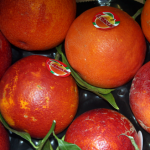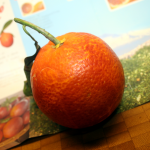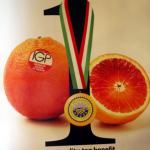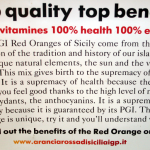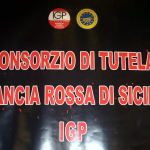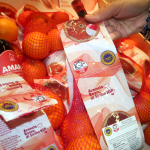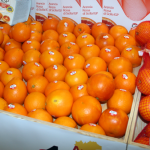Blood oranges in the Quick Check, KaDeWe, Sanlucar, Struwwelpeter, Il Fragolino, Moretti, Valensina Sanguinelli, IGP, Rosaria
Blood oranges in the Quick Check
I love blood oranges, but as it is always the case, you usually only buy a few and as soon as you have noticed that they were particularly tasty, there are no more of those to get – or the newly bought ones suddenly taste completely different.
Blood oranges taste significantly more intense than their “bloodless” relatives, they contain different amounts of vitamin B, C, E as well as potassium and calcium depending on the variety and are therefore extremely healthy & photogenic.
The colour of the fruit flesh in blood oranges is caused by anthocyanin – the amount of anthocyanin depends on temperature fluctuations during the day and also influences the colour content of the skin (exocarp, flavedo). Particularly “respectable” fruits can be found near the volcano Etna, but also in the USA, South Africa and the entire Mediterranean region.
Depending on the variety (Moro, Sanguine, Tarocco, etc.), the sometimes stronger or less strongly formed white layer between the skin and the flesh of the fruit is called mesocarp or albedo. Here – as with conventional oranges – is often the biggest “disturbance” during consumption, because most people want to eat as little of it as possible.
Therefore, after peeling, a complex cleaning is often necessary – if you have to do it yourself, the pleasure is often already clouded. In addition, it often happens that when juice oranges are pressed too intensively, the albedo makes the juice bitter. What is also annoying is that the juice already comes out of the flesh during peeling, but at the latest during cleaning, which often makes the whole thing quite sticky.
Whether the blood oranges had seeds was not so important to me in this CheckIt – if you consider that naturally fruit multiplies through its seeds, you cannot really consider seed lessness – even if it is more fun to eat – a plus point. If, however, there had been more seeds than enough in a fruit, I would at least have mentioned that. In total, with three tasted fruits there were only six seeds.
There are several sorts of the so-called blood orange – mostly the Moro (deep red) & Tarocco (slightly red) are offered. A good option not to have to deal with the varieties is, for example, to orient oneself to the suppliers.
These blood oranges then usually have a product name and one is more purposeful in such a thing with that which gets into the hands during the purchase. But there is never a guarantee.
For this small CheckIt I bought three different blood orange varieties from the Berlin KaDeWe. Why at the KaDeWe? On the one hand, because it is a pleasure to shop for culinary delights, on the other hand, because only very, very few shops have more than just Moro in their portfolio as standard.
After my visit to FRUIT LOGISTICA 2017, I was able to add five more blood oranges to the article.
Very important: My focus was on taste, handling & appearance.
Further information on varieties, growing areas and characteristics of the described fruits can be found for example at Wikipedia or on the respective producer websites.
Supplier KaDeWe
The producer was unfortunately not named, the variety is Moro, origin Italy/Sicily
Plus
The Moro was quite sweet, but still had enough acidity not to taste boring. In the bite this orange was sufficiently firm and the flesh was of a strong red colour.
Minus
The Moro was relatively difficult to peel and had to be cleaned afterwards.
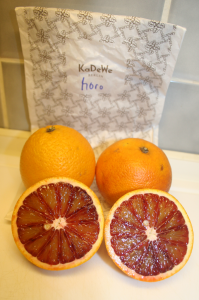
On a scale of 0-5, Moro gets 3-4/5 points from me.
Supplier Sanlucar
Sanlucar “Red Sun”, variety not named – probably a Tarocco, origin Italy/Sicily
Plus
The Sanlucar blood oranges were extremely easy to peel and very little albedo adhered to the fruit, so no cleaning was necessary and the fruit could be enjoyed immediately. This blood orange was very juicy and had a balanced sweetness / acidity ratio.
Minus
The Sanlucar has only very small traces of red pigments and is therefore sometimes difficult to identify as blood orange.
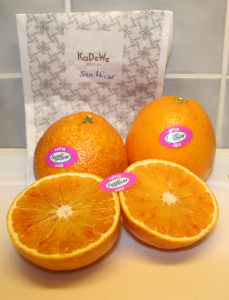
On a scale of 0-5, Sanlucar gets 5/5 points from me.
Supplier Struwwelpeter
Struwwelpeter, variety not named, origin supposedly Italy/Sicily
Plus
The Struwwelpeter are suitable because of their look certainly well for food photography.
Minus
The Struwwelpeter was relatively difficult to peel in comparison and had to be cleaned afterwards. It was only moderately juicy and the flesh much less red than, for example, the Moro. Above all, however, the Struwwelpeter had a lot of acidity and reminded taste strongly of a lemon.
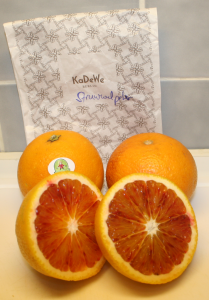
On a scale of 0-5, Struwwelpeter gets only 2-3/5 points from me.
[Update 2017-02-20]
During the FRUIT LOGISTICA 2017 I found five more great blood oranges and included them for you in the following CheckIt of January
Supplier Il Fragolino (Tarocco Lempso, Arancia Rossa)
The Il Fragolino are due to their great & natural look extremely well suited for food photography.
Plus
This blood orange is a credit to your “guild” – it looks great, comes with foliage, smells very intense and has a captivating taste. It has just enough sweetness paired with typical strong “volcano aroma”. In addition, the fruit is easily released when peeled and has hardly any albedo on the flesh.
Minus
None

On a scale of 0-5, Il Fragolino gets 5/5 points from me.
Supplier Moretti
The Moretti, a Tarocco in appearance, is conditionally suitable for food photography.
Plus
The inside of this blood orange has a good look – a light red streak makes it at least inside a little bit look. It has a bit more acidity than some other varieties, but the ratio is subjectively still OK. The Moretti is also very juicy and easy to peel.
Minus
none
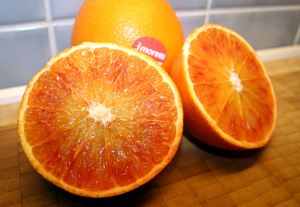
On a scale of 0-5, I give the Moretti 4/5 points.
Vendor Valensina Sanguinelli (from Spain)
The Valensina Sanguinelli, an orange to juice.
Plus
The fruits have a super blood orange look which is not so “repeated” inside. This blood orange has a well-balanced acidity and is an excellent juice orange in this caliber.
Minus
The interior is visually moderately interesting, that Albedo unfortunately very strong and the fruit elaborate to peels.
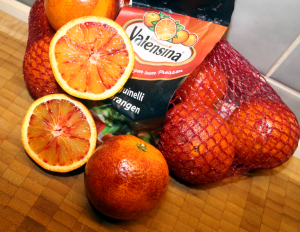
On a scale of 0-5, Valensina Sanguinelli gets 3-4/5 points from me.
Supplier IGP (Sicily)
The term Arancia Rossa di Sicilia covers the Moro, Sanguinello and Tarocco varieties. The IGP has set itself the goal of establishing a protected geographical indication – as is the case, for example, with balsamic vinegar. The blood oranges offered directly at the IGP stall were mainly Tarocco.
Plus
The IGP blood orange was very easy to peel, was remarkably sweet.
Minus
Besides the sweetness there was unfortunately a certain lack of acidity and thus the hoped-for taste “fire”. Moreover, the IGP was not so photogenic and looked from the outside more like a normal orange – from the inside then like the other Taroccos too.

On a scale of 0-5, the tasted IGP gets 3-4/5 points from me.
Vendor Rosaria
Rosaria also comes from the Etna region and, in my opinion, is more suitable for juice than for direct consumption in tasted calibre. However, the producer also cultivates all known Sicilian blood oranges and some crossings.
Plus
The Rosaria was easy to peel, quite sweet and juicy. The inside looked a lot like Moro – it was not clear if this was so or if here a crossing was the case.
Minus
Unlike the interior, the Rosaria is clearly boring in appearance. The fruit had clearly too little acidity / fire.

On a scale of 0-5, Rosaria gets 3/5 points from me.
Conclusion [2017-01-29]
From my point of view the winner of this small CheckIt is clearly the blood orange “Red Sun” from Sanlucar. This orange was able to convince not only by its outstanding taste but also by its good “handling”. You could enjoy it without much effort and sticky hands and still had a noticeably fresh and juicy fruit.
Conclusion Update [2017-02-20]
After tasting another five varieties, I have to correct myself. My absolute top favourite is the Il Fragolino. Not only that the employees of these producers seemed to be the most authentic – the fruits were a feast for the eyes as well as they tasted a whole category above all others. Here you could taste the fire of Etna – respect for so much love for the fruit and such a good result of “craftsmanship”.



